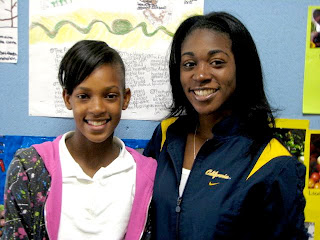 UC Berkeley sophomore Anna Fretz and Sankofa Academy 4th-grader Imani’s high-five echoes in the school’s otherwise quiet second-floor hallway. It’s the sound of success: The duo has worked together weekly since September as part of Berkeley’s Sage Mentorship Project, and Imani just posted a Math score in the 95th percentile. “I’m so proud of you!” Anna tells Imani.
UC Berkeley sophomore Anna Fretz and Sankofa Academy 4th-grader Imani’s high-five echoes in the school’s otherwise quiet second-floor hallway. It’s the sound of success: The duo has worked together weekly since September as part of Berkeley’s Sage Mentorship Project, and Imani just posted a Math score in the 95th percentile. “I’m so proud of you!” Anna tells Imani.“Anna helps me improve in both English and Math,” Imani says. “What was that problem you helped me with? Oh, I was working on denominators and numerators – we had to make the denominators equal. Anna helped me with that and then I got it.”
“I love doing this,” Anna says. “It’s a really direct form of support, and I get to see how much Imani improves.”
Beyond academic milestones, the Sage Project has built lasting bonds among the college mentors and their 3rd-, 4th-, and 5th-grade mentees. “We’ve developed such a close connection that it’s become a genuine friendship,” says Anna. Imani agrees, describing their rapport as “natural. Anna’s nice and we have a good understanding of each other.”
4th-grader Le Asia, who’s been paired with Berkeley’s Andrew Spencley since September 2009, notes the unique dynamic this one-on-one mentoring creates. “Andrew helps me by explaining things in a different type of way. If you’re behind in class, the mentors help you catch up.”
 “The coolest thing is seeing the progression,” Andrew reflects. “I’ve worked with her in 3rd grade and now in 4th, and you see the huge impact a couple hours a week can make. I feel like it’s the highlight of both of our weeks!”
“The coolest thing is seeing the progression,” Andrew reflects. “I’ve worked with her in 3rd grade and now in 4th, and you see the huge impact a couple hours a week can make. I feel like it’s the highlight of both of our weeks!”“I don’t see Sage as something that’s just beneficial for our kids,” says 5th-grade teacher China Byon. “It’s mutually beneficial for mentor and mentee, and I’ve noticed that the best pairings occur when they both understand that. They’re here forming new bonds, and it’s about making connections and being part of the larger community.”
“I want to go to Cal…”
For Sankofa’s kids, connecting with Berkeley students makes college a relatable, tangible goal. While several mentees’ siblings are in college, “weekly contact with a college student may not be something they have,” says Byon.
“It gives them the idea that they can go to college,” explains sophomore Vachel Samuels, Jr., who mentors 5th-grader Premier. “If we come back and give back, they see they can be successful, that they can have the opportunities that I do.”
Premier has clearly taken the experience to heart. “I want to go to college, I want to go to Cal,” he says.
Berkeley senior Cina wants to take the college connection even further. “You should come on a tour of Cal with me,” he tells 5th-grader Jailynn.
It’s all about the connection,” says Cina. “Whatever she’s doing, I help her with. Sometimes we talk about stuff outside of school. I’ll give her my two cents on whatever’s going on, even if she doesn’t want to hear it…” Jailynn starts to laugh, sensing where this running joke is going. “Like what I think about Justin Bieber!”
“Some people don’t have mentors or people to help them out in life,” reflects Jailynn. “I think having a mentor is a privilege, so you have to think and learn and put a lot into it.”
 “I never had anything like this when I was in elementary school,” says Berkeley senior Montoya Mayo, who mentors 5th-grader Amya. “It’s just a great experience, getting to build a new relationship. We talk about any and everything. I know Amya’s favorite food is mac and cheese and ribs, and she really likes Silly Bandz.”
“I never had anything like this when I was in elementary school,” says Berkeley senior Montoya Mayo, who mentors 5th-grader Amya. “It’s just a great experience, getting to build a new relationship. We talk about any and everything. I know Amya’s favorite food is mac and cheese and ribs, and she really likes Silly Bandz.”Amya is grateful for the academic boost as well. She recently made the semifinals of Oakland Unified’s Spelling Bee Championship, where she was proud to represent her school. “I felt like everybody wanted me to win, for Sankofa.”
“Montoya gives me extra help in all of [my schoolwork]. One on one, you get more attention than [during regular class time],” she explains. “Montoya says she got a scholarship to Cal. That makes me want to have a scholarship, too. I’m thinking about going to Harvard, Yale, Georgetown, or Stanford!”
Listening to Amya, it seems a safe bet that the mentorship experience will have a lasting impact. Not only has it put a picture of college clearly in her mind, but she also hopes to be a mentor one day herself, “so I can meet new people and help younger kids with their work, like Montoya does with me.”
The Sage Mentorship program is creating lasting relationships between Sankofa scholars and college students, but another organization, Experience Corps, is extending inter-generational connections even further. Our next Sankofa Reflections will chronicle this partnership, which is building bridges across generations. (Experience Corps’ volunteers are all 55 years of age and older.)












